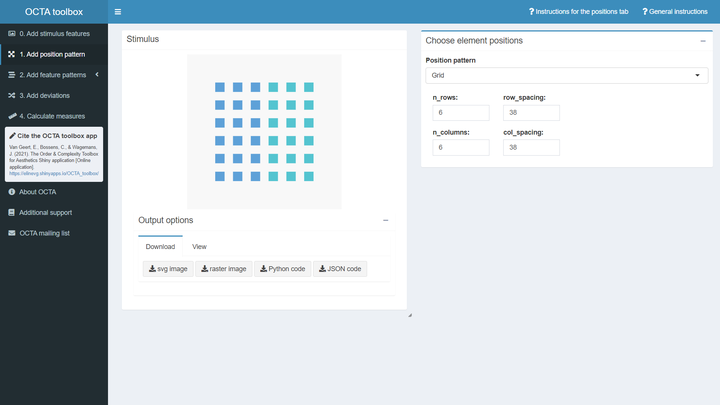The Order & Complexity Toolbox for Aesthetics (OCTA): A systematic approach to study the relations between order, complexity, and aesthetic appreciation

Abstract
Do individuals prefer stimuli that are ordered or chaotic, simple or complex, or that strike the right balance of order and complexity? Earlier research mainly focused on the separate influence of order and complexity on aesthetic appreciation. When order and complexity were studied in combination, stimulus manipulations were often not parametrically controlled, only rather specific types of order (i.e., balance or symmetry) were studied, and/or the multidimensionality of order and complexity was ignored. Progress has also been limited by the lack of an easy way to create reproducible and expandible stimulus sets, including both order and complexity manipulations. The Order & Complexity Toolbox for Aesthetics (OCTA), a Python toolbox that is also available as a point-and-click Shiny application, aims to fill this gap. OCTA provides researchers with a free and easy way to create multi-element displays varying qualitatively (i.e., different types) and quantitatively (i.e., different levels) in order and complexity, based on regularity and variety along multiple element features (e.g., shape, size, color, orientation). The standard vector-based output is ideal for experiments on the web and the creation of dynamic interfaces and stimuli. OCTA will not only facilitate reproducible stimulus construction and experimental design in research on order, complexity, and aesthetics. In addition, OCTA can be a very useful tool in any type of research using visual stimuli, or even to create digital art. To illustrate OCTA’s potential, we will propose several possible applications and diverse questions that can be addressed using OCTA.
Reference:
Van Geert, E., Bossens, C., & Wagemans, J. (2023). The Order & Complexity Toolbox for Aesthetics (OCTA): A systematic approach to study the relations between order, complexity, and aesthetic appreciation. Behavior Research Methods, 55, 2423–2446. https://doi.org/10.3758/s13428-022-01900-w
Postprint available from: https://doi.org/10.31234/osf.io/2bu8a